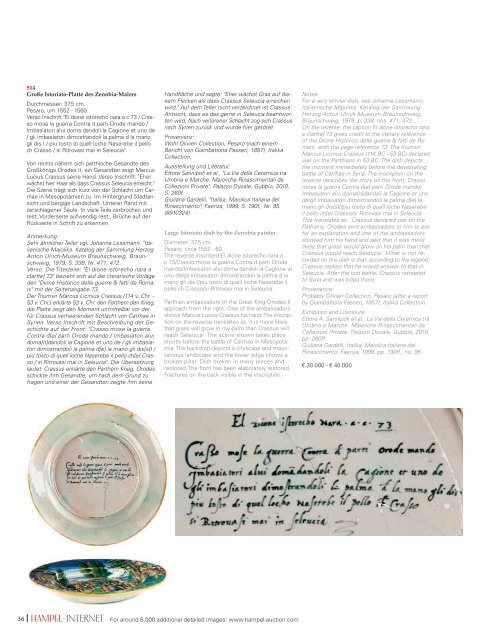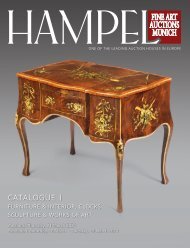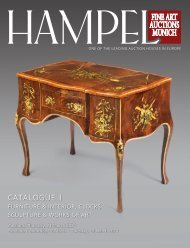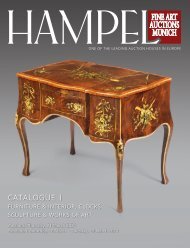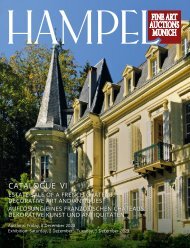Sammlung Majolika
- Keine Tags gefunden...
Sie wollen auch ein ePaper? Erhöhen Sie die Reichweite Ihrer Titel.
YUMPU macht aus Druck-PDFs automatisch weboptimierte ePaper, die Google liebt.
514<br />
Große Istoriato-Platte des Zenobia-Malers<br />
Durchmesser: 37,5 cm.<br />
Pesaro, um 1552 - 1560.<br />
Verso Inschrift "El dione istorecho nara a c 73 / Cras -<br />
so mose la guerra Contra d parti Orode mando /<br />
Imbasiatori alui doma dandoli la Cagione et uno de<br />
/ gli imbasiatori dimostrandoli la palma d la mano<br />
gli dis I / piu tosto di quell loche Naserebe il pello<br />
ch Crasso / si Ritrovasi mai in Seleucia".<br />
Von rechts nähern sich parthische Gesandte des<br />
Großkönigs Orodes II, ein Gesandter zeigt Marcus<br />
Lucius Crassus seine Hand. Verso Inschrift: "Eher<br />
wächst hier Haar als dass Crassus Seleucia erreicht."<br />
Die Szene trägt sich kurz von der Schlacht um Car -<br />
rhae in Mesopotamien zu. Im Hintergrund Stadtan -<br />
sicht und bergige Landschaft. Unterer Rand mit<br />
zerschlagener Säule. In viele Teile zerbrochen und<br />
rest. Vorderseite aufwendig rest., Brüche auf der<br />
Rückseite in Schrift zu erkennen.<br />
Anmerkung:<br />
Sehr ähnlicher Teller vgl. Johanna Lessmann, "Ita -<br />
lie nische <strong>Majolika</strong>. Katalog der <strong>Sammlung</strong> Herzog<br />
Anton Ulrich-Museum Braunschweig, Braun -<br />
schweig, 1979, S. 338, Nr. 471, 472.<br />
Verso: Die Titelzeile: "El dione istorecho nara a<br />
c[artte] 73" bezieht sich auf die literarische Vorlage<br />
den "Dione Historico delle guerre & fatti de Roma -<br />
ni" mit der Seitenangabe 73.<br />
Der Triumvir Marcus Licinius Crassus (114 v. Chr. -<br />
53 v. Chr.) erklärte 53 v. Chr. den Parthern den Krieg,<br />
die Platte zeigt den Moment unmittelbar vor der<br />
für Crassus verheerenden Schlacht von Carrhae in<br />
Syrien. Verso Inschrift mit Beschreibung der Ge -<br />
schichte auf der Front: "Crasso mose la guerra<br />
Contra d[e] parti Orode mando / Imbasiatori alui<br />
doma[n]dandoli la Cagione et uno de / gli imbasiatori<br />
dimostrandoli la palma d[e] la mano gli dis[s]I /<br />
piu tosto di quell loche Naserebe il pello ch[e] Cras -<br />
so / si Ritrovasi mai in Seleucia". Die Übersetzung<br />
lautet: Crassus erklärte den Parthern Krieg, Orodes<br />
schickte ihm Gesandte, um nach dem Grund zu<br />
fragen und einer der Gesandten zeigte ihm seine<br />
Handfläche und sagte: "Eher wächst Gras auf die -<br />
sem Flecken als dass Crassus Seleucia erreichen<br />
wird." Auf dem Teller nicht verzeichnet ist Crassus'<br />
Antwort, dass es das gerne in Seleucia beantwor -<br />
ten wird. Nach verlorener Schlacht zog sich Crassus<br />
nach Syrien zurück und wurde hier getötet.<br />
Provenienz:<br />
Wohl Olivieri Collection, Pesaro (nach einem<br />
Bericht von Giambattista Passeri, 1857); Italika<br />
Collection.<br />
Ausstellung und Literatur:<br />
Ettore Sannipoli et al., "La Via della Ceramica tra<br />
Umbria e Marche. Maioliche Rinascimentali da<br />
Collezioni Private", Palazzo Ducale, Gubbio, 2010,<br />
S. 260f.<br />
Giuliana Gardelli, "Italika, Maiolica Italiana del<br />
Rinascimento", Faenza, 1999, S. 190f., Nr. 95.<br />
(8910324)<br />
Large Istoriato dish by the Zenobia painter<br />
Diameter: 37.5 cm.<br />
Pesaro, circa 1552 - 60.<br />
The reverse inscribed El dione istorecho nara a<br />
c 73/Crasso mose la guerra Contra d parti Orode<br />
mando/Imbasiatori alui doma dandoli la Cagione et<br />
uno de/gli imbasiatori dimostrandoli la palma d la<br />
mano gli dis I/piu tosto di quell loche Naserebe il<br />
pello ch Crasso/si Ritrovasi mai in Seleucia.<br />
Parthian ambassadors of the Great King Orodes II<br />
approach from the right. One of the ambassadors<br />
shows Marcus Lucius Crassus his hand. The inscription<br />
on the reverse translates as 'it is more likely<br />
that grass will grow in my palm than Crassus will<br />
reach Seleucia'. The scene shown takes place<br />
shortly before the battle of Carrhae in Mesopota -<br />
mia. The backdrop depicts a cityscape and mountainous<br />
landscape and the lower edge shows a<br />
broken pillar. Dish broken in many pieces and<br />
restored. The front has been elaborately restored.<br />
Fractures on the back visible in the inscription.<br />
Notes:<br />
For a very similar dish, see Johanna Lessmann,<br />
Italienische <strong>Majolika</strong>. Katalog der <strong>Sammlung</strong><br />
Herzog Anton Ulrich-Museum Braunschweig.<br />
Braunschweig, 1979, p. 338, nos. 471, 472.<br />
On the reverse: the caption El dione istorecho nara<br />
a c[artte] 73 gives credit to the literary reference<br />
of the Dione Historico delle guerre & fatti de Ro -<br />
ma ni, with the page reference 73. The triumvir<br />
Marcus Licinius Crassus (114 BC - 53 BC) declared<br />
war on the Parthians in 53 BC. The dish depicts<br />
the moment immediately before the devastating<br />
battle of Carrhae in Syria. The inscription on the<br />
reverse describes the story on the front: Crasso<br />
mose la guerra Contra d[e] parti Orode mando/<br />
Imbasiatori alui doma[n]dandoli la Cagione et uno<br />
de/gli imbasiatori dimostrandoli la palma d[e] la<br />
mano gli dis[s]I/piu tosto di quell loche Naserebe<br />
il pello ch[e] Crasso/si Ritrovasi mai in Seleucia.<br />
This translates as: 'Crassus declared war on the<br />
Pathians, Orodes sent ambassadors to him to ask<br />
for an explanation and one of the ambassadors<br />
showed him his hand and said that it was more<br />
likely that grass would grow on his palm than that<br />
Crassus would reach Seleucia'. What is not re -<br />
corded on this dish is that, according to the legend,<br />
Crassus replied that he would answer to that in<br />
Seleucia. After the lost battle, Crassus retreated<br />
to Syria and was killed there.<br />
Provenance:<br />
Probably Olivieri Collection, Pesaro (after a report<br />
by Giambattista Passeri, 1857); Italika Collection.<br />
Exhibition and Literature:<br />
Ettore A. Sannipoli et al., La Via della Ceramica tra<br />
Umbria e Marche. Maioliche Rinascimentali da<br />
Collezioni Private. Palazzo Ducale, Gubbio, 2010,<br />
pp. 260ff.<br />
Giuliana Gardelli, Italika, Maiolica Italiana del<br />
Rinascimento, Faenza, 1999, pp. 190ff., no. 95.<br />
€ 30.000 - € 40.000<br />
36<br />
For around 6,000 additional detailed images: www.hampel-auction.com


